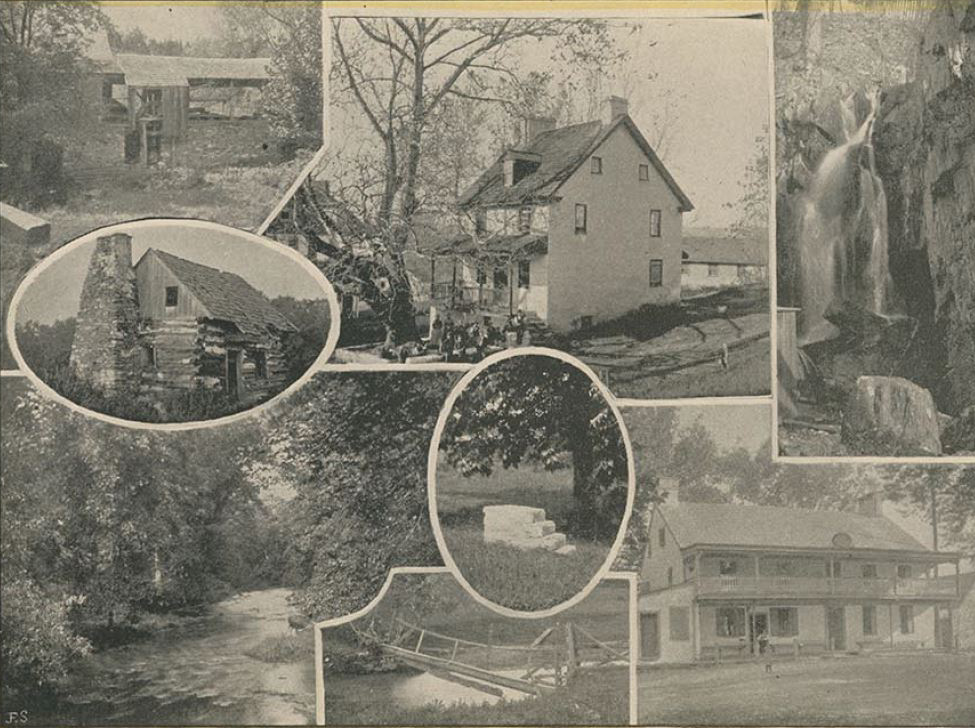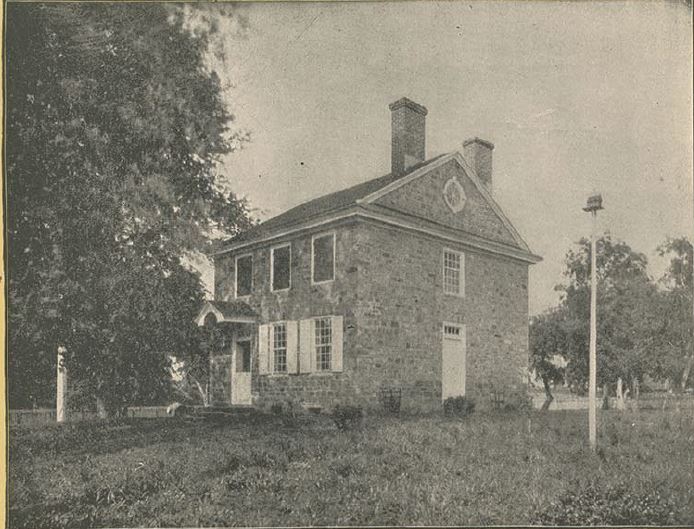 |
|
Tredyffrin Easttown Historical Society Home
: Document Collection Home
Use the links at the left to return.
|
|||||||||
Document Collection |
|||||||||
The Old Baptist RoadSecond Ramble |
|||||||||
|

From the turnpike to the left at “Dallett’s” we strike the “Old Baptist Road.” A short half mile brings us to the new Convalescent Home, erected largely by the munificence of Lady Kortright. A few hundred rods down a private lane is “Hammer Hollow,” an exquisitely romantic glen, through which runs a stream having a great fall and steady volume of water, that for a century past has furnished the power for several mills. In former years a “Tilt-hammer” was located at the Upper Dam, while a saw and slitting mill, as well as a turning lathe were situated lower down the ravine. From the noise of the hammer echoing back and forth through the ravine the locality became known as “Hammer Hollow.” Many are legends and weird tales told of this little Valley and its inhabitants. Prior to the Revolution, when iron mills were running up to their capacity, a traveler from Philadelphia, whose business called him there, stopped for the night at a small Inn near the Upper Dam. The next morning, shortly after arising, he heard his hostess tell her daughter to kill a couple of snakes for the gentleman’s breakfast. While hardly believing, he still determined to investigate, so following the little girl out he asked where she was going. Her reply was not that she was “Going a-milking,” but in fact on a snake-killing expedition. Soon after her return breakfast was announced, and the visitor surveyed the table with a great misgiving, but saw nothing which savored of writhing reptiles. After partaking of a not very sumptuous fare, four fried eggs the story goes, he asked for an explanation of the snake order; when she explained to him that snakes were so plentiful in the Hollow that they always got the hen’s eggs before she could collect them, so whenever eggs were wanted they sent to the hen house and watched for black snakes, and killed them to recover one or two eggs from each. Another story is of the invention of the augur, now in use by every carpenter. Two boys were playing in this romantic glen early in 1774. They had in their hand a piece of hoop iron, turning it round and round in the ground it soon became twisted and brought out the dirt at every turn. A workman passing noticed the peculiarity and thought of the possibility of making a tool for boring wood on the same principle. He tried it and found it a great improvement over the pod auger then in use and it became the forerunner of the screw auger of the present day. Returning to the road from Hammer Hollow we resume our course down the Baptist Road, which winds through the sproutland and laurel on the northern slope of the Valley Hill, and we soon reach the Great Valley Baptist Church, surrounded by the graves of generations of worshippers. This church, the oldest in Pennsylvania, was erected in 1710. The Rev. David Jones, the fighting parson of Wayne’s Brigade, was for many years its pastor. In September, 1777, after destroying the parson’s home but failing to catch the parson, General Howe, for further vengeance, gave orders to ransack and pillage the Church, and British spite was wrecked on the Holy vessels and furniture of the old sanctuary. A little further on after passing the Chester Valley Road we reach New Centerville, an old crossroads country hamlet, where, during the Revolutionary [War], was established a post known as “The Stone Chimney Picket.” At the intersection of the Swedesford Road, a few rods beyond, the Society of the Sons of the Revolution have lately erected the substantial granite monument, shown in the initial letter of this chapter. During the Revolution both armies marched and counter-marched over this road, as did the army sent eighteen years later by Washington to put down the Whiskey Insurrection. From the fact that the advance guard at this latter date, which was composed of New Jersey troops, had several wagon loads of melons in their train, the whole army became known as the “Watermelon Army.” Another noted landmark on this highway is the Great Valley Presbyterian Church, the second oldest congregation in this State. It was in this Church at the outbreak of the Revolution, that Rev. Daniel McCalls, prior to his appointment as Chaplain, by the Continental Congress, thanked the Almighty that there was no such thing as a Tory in his congregation. If we continue north on the Baptist Road, a short drive brings us to the head of the Valley Dam, with General Knox’s headquarters on the right, and Lafayette’s to the left of the road. Crossing the bridge a road through the gap between Mounts Joy and Misery opens up a romantic drive, not surpassed even by the far-famed Wissahickon. As we near the Schuylkill we arrive at the Potts house, which was used by Washington as his headquarters during the winter of 1777-78. An engraving of this historic house is shown on the preceding page. The building is now in charge of a janitor who gives much information regarding the rooms and relics they contain, and shows the visitors the subterranean passage from the cellar to the banks of the Schuylkill which has recently been re-opened. This passage was intended for the use of Washington should he have found it necessary to escape.  Washington’s Headquarters Leaving this spot, if we drive eastward over the Camp Hill, the lines of fortifications and the site of Sullivan’s bridge can yet be clearly traced; next is Fatland Ford at the end of the Baptist Road, where the British Army crossed, giving Washington the “slip” on the march to Philadelphia; or we may go west from the headquarters, and a short drive through the straggling village of Valley Forge brings us to Morehall, once the home of the old aristocrat, William Moore, mentioned in connection with the Radnor church. From Morehall the road leads to Phoenixville, or we can turn to the left and go to Diamond Rock, and thence to Howelltown on the Swedesford Road. From this point the visitor has a choice of roads to Paoli, Berwyn, or back to Devon, all leading through romantic wooded lanes and shaded glens, every inch being ground well-known to the heroes who suffered there during the terrible winter of 1777. |